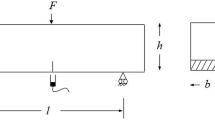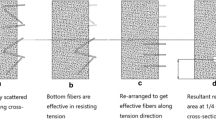Abstract
A semi-analytical model is presented, based on conventional principles of mechanics, to predict the flexure behaviour of steel fibre reinforced concrete. The model uses a stress-block approach to represent the stresses that develop at a cracked section by three discrete stress zones: (a) a compressive zone; (b) an uncracked tensile zone; and (c) a cracked tensile zone. It is further shown that the stress-block, and hence flexural behaviour, is a function of five principal parameters: compressive stress–strain relation; tensile stress–strain relation; fibre pull-out behaviour; the number and distribution of fibres across the cracked section in terms of their positions, orientations and embedment lengths; and the strain/crack-width profile in relation to the deflection of the beam. An experimental investigation was undertaken on both cast and sprayed specimens to obtain relationships for use in the model. The results of the study showed a reasonable agreement between the model predictions and experimental results. However, the accuracy of the model is probably unacceptable for it to be currently used in design. A subsequent analysis highlighted the single fibre pull-out test and the sensitivity of the strain analysis tests as being the main cause of the discrepancies.
















Similar content being viewed by others
References
RILEM TC 162-TDF (2001) Test and design methods for steel fibre reinforced concrete – uni-axial tension test for steel fibre reinforced concrete. Mater Struct 34(1):3–6
Casanova P, Rossi P (1996) Analysis of metallic fibre-reinforced concrete beams submitted to bending. Mater Struct 29:354–361
Armelin HS, Banthia N (1997) Predicting the flexural postcracking performance of steel fiber reinforced concrete from the pullout of single fibers. ACI Mater J 94(1):18–31
RILEM TC 162-TDF (2002) Test and design methods for steel fibre reinforced concrete – σ-ε design method. Mater Struct 35:262–278
Ulfkjaer J, Krek S, Brincker R (1995) Analytical model for fictitious crack propagation in concrete beam. ASCE J Eng Mech 121(1):7–15
Hillerborg A (1980) Analysis of fracture by means of the fictitious crack model particularly for fibre reinforced concrete. Int J Cem Compos 2(4):177–184
Wecharatana M, Shah SP (1983) A model for predicting fracture resistance of fiber reinforced concrete. Cem Concr Res 13:819–829
Robins PJ, Austin SA, Jones PA (1996) Flexural modelling of steel fibre reinforced sprayed concrete. In: Sprayed Concrete Technology. Proceedings of the ACI/SCA International Conference on Sprayed Concrete/Shotcrete, Edinburgh, Sept. 1996 E&FN Spon, London, pp 107–114
Robins PJ, Austin SA, Chandler JM, Jones PA (2001) Flexural strain and crack width measurement of steel-fibre-reinforced concrete by optical grid and electrical gauge methods. Cem Concr Res 31(5):719–729
Robins PJ, Austin SA, Jones PA (2002) Pull-out behaviour of hooked steel fibres. Mater Struct 35:434–442
Robins PJ, Austin SA, Jones PA (2003) Spatial distribution of steel fibres in sprayed and cast concrete. Mag Concr Res 55(3):225–235
Jones PA (1998) Flexural modelling of steel fibre reinforced sprayed concrete, Ph.D Thesis Loughborough University, England
BS 12 (1992) Specification for Portland Cements, British Standards Institution, Milton Keynes
EFNARC (1996) European Specification for Sprayed Concrete, European Federation of National Association of Specialist Repair Contractors and Material Suppliers for the Construction Industry, Aldershot, UK
BS 1881: Part 121 (1983) Method of determination of static modulus of elasticity in compression, British Standards Institution, Milton Keynes
Gopalaratnam VS, Shah SP (1985) Softening response of plain concrete in direct tension. ACI J 82:310–323
Prudencio L, Austin SA, Jones PA, Armelin HS, Robins PJ (2006) Prediction of steel fibre reinforced concrete under flexure load from an inferred fibre pull-out response. Mater Struct 39:599–608
Acknowledgements
The authors are grateful to Gunform Ltd for their assistance with the sprayed concrete field trials.
Author information
Authors and Affiliations
Corresponding author
Rights and permissions
About this article
Cite this article
Jones, P.A., Austin, S.A. & Robins, P.J. Predicting the flexural load–deflection response of steel fibre reinforced concrete from strain, crack-width, fibre pull-out and distribution data. Mater Struct 41, 449–463 (2008). https://doi.org/10.1617/s11527-007-9327-9
Received:
Accepted:
Published:
Issue Date:
DOI: https://doi.org/10.1617/s11527-007-9327-9




